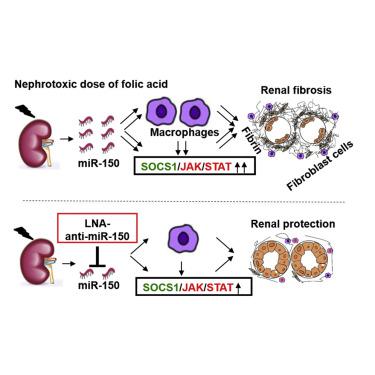Molecular Therapy - Nucleic Acids ( IF 6.5 ) Pub Date : 2020-10-14 , DOI: 10.1016/j.omtn.2020.10.008 Junjun Luan 1 , Jingqi Fu 2 , Dongdong Wang 1 , Congcong Jiao 1 , Xiangfei Cui 1 , Chengjie Chen 2 , Dan Liu 2 , Yixiao Zhang 3 , Yanqiu Wang 1 , Peter S T Yuen 4 , Jeffrey B Kopp 5 , Jingbo Pi 2 , Hua Zhou 1

|
We investigated whether microRNA-150 (miR-150)-based RNA interference (RNAi) ameliorates tubular injury and tubulointerstitial fibrosis. Mice injected with folic acid developed tubulointerstitial fibrosis at day 30. miR-150 levels were increased at day 7 and peaked at day 30. At day 30, protein levels of α-smooth muscle actin, fibronectin (FN), and collagen 1 (COL-1) were increased, while suppressor of cytokine signal 1 (SOCS1) was decreased. Kidneys manifested increased macrophage numbers and increased expression of potential mediators: interferon-γ, interleukin-6, and tumor necrosis factor-α. Locked nucleic acid-anti-miR-150, started prior to or after tubular injury and administered twice weekly for 4 weeks, reversed renal inflammation and fibrosis. In HK-2 cells, co-culture with macrophages increased miR-150 expression and decreased SOCS1. Janus kinase (JAK) and signal transducer and activators of transcription (STAT) pathway-related proteins p-JAK1, p-JAK2, p-STAT1, p-STAT3, and pro-fibrotic genes encoding α-smooth muscle actin, FN, and COL-1 were all upregulated. The miR-150 antagonist reversed these transcriptional changes. Lastly, in renal biopsies from patients with chronic interstitial fibrosis, renal miR-150, and pro-fibrotic gene expression and macrophage numbers were increased, while SOCS1 expression was decreased. In conclusion, miR-150-based RNAi is as a potential novel therapeutic agent for tubulointerstitial fibrosis, suppressing the SOCS1/JAK/STAT pathway and reducing macrophage influx.
中文翻译:

基于 miR-150 的 RNA 干扰通过 SOCS1/JAK/STAT 通路在体内和体外减轻肾小管间质纤维化
我们研究了基于 microRNA-150 (miR-150) 的 RNA 干扰 (RNAi) 是否可以改善肾小管损伤和肾小管间质纤维化。注射叶酸的小鼠在第 30 天出现肾小管间质纤维化。miR-150 水平在第 7 天增加,并在第 30 天达到峰值。第 30 天,α-平滑肌肌动蛋白、纤连蛋白 (FN) 和胶原蛋白 1 (COL) 的蛋白质水平-1) 增加,而细胞因子信号抑制因子 1 (SOCS1) 减少。肾脏表现出巨噬细胞数量增加和潜在介质表达增加:干扰素-γ、白细胞介素-6和肿瘤坏死因子-α。锁核酸抗 miR-150 在肾小管损伤之前或之后开始,每周给药两次,持续 4 周,可逆转肾脏炎症和纤维化。在 HK-2 细胞中,与巨噬细胞共培养可增加 miR-150 表达并减少 SOCS1。 Janus 激酶 (JAK) 和信号转导子和转录激活子 (STAT) 通路相关蛋白 p-JAK1、p-JAK2、p-STAT1、p-STAT3 以及编码 α-平滑肌肌动蛋白、FN 和 α-平滑肌肌动蛋白的促纤维化基因COL-1 均上调。 miR-150 拮抗剂逆转了这些转录变化。最后,在慢性间质纤维化患者的肾活检中,肾脏 miR-150 和促纤维化基因表达以及巨噬细胞数量增加,而 SOCS1 表达减少。总之,基于 miR-150 的 RNAi 是一种潜在的肾小管间质纤维化新型治疗剂,可抑制 SOCS1/JAK/STAT 通路并减少巨噬细胞流入。


















































 京公网安备 11010802027423号
京公网安备 11010802027423号